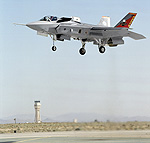U.K. considers dropping STOVL version of F-35
 LONDON — Britain may drop plans to purchase the short-takeoff, vertical-landing (STOVL) version of the Lockheed Martin F-35 strike aircraft and replace it with the conventional carrier variant of the Lighting II.
LONDON — Britain may drop plans to purchase the short-takeoff, vertical-landing (STOVL) version of the Lockheed Martin F-35 strike aircraft and replace it with the conventional carrier variant of the Lighting II.
Government and industry sources here said the switch of aircraft types to the F-35C has been under review and a decision could emerge when the strategic defense and security review is rolled out Tuesday.
The first signal that the British might be changing their minds came in the joint foreword to a new national security strategy, written by Prime Minister David Cameron and Deputy Prime Minister Nick Clegg, released Monday.
Complaining about the extent of Cold-War era weapons remaining in service, the foreword said Britain had “two massive aircraft carriers on order but [were] unable to operate with the aircraft of our closest allies.”
The sources said the Cameron/Clegg statement indicated not only that the two 65,000-ton warships will be built but that at least one of the vessels will likely be fitted with the catapult and arresting gear required to allow conventional fighters to operate from its deck.
The Conservative-led coalition government has considered cancelling both the carriers as part of defense spending cuts due to be unveiled this week.
The cuts are expected to amount to about 8 percent over four years. Royal Air Force fast jets, warships and artillery are expected to be amongst the casualties.
An MoD spokesman wouldn’t be drawn on whether a decision would be announced Tuesday, but said if the British went for the conventional carrier variant, it would be “cheaper, deliver more capability and go further.”
The U.S. Navy is the only customer at present for the F-35C version of the aircraft.
Lockheed Martin officials declined to comment.
Britain has already purchased a small number of STOVL JSF aircraft for test and evaluation, and was scheduled to make a decision on acquiring further machines next year for training purposes.
Fitting the system, known as “cats and traps” in the U.S. Navy, would allow French and U.S. Navy jets to cross-deck with the British.
Britain selected the STOVL version of the F-35 in 2002 for a joint Royal Navy-Royal Air Force fleet to replace the Harrier and fulfill the Joint Combat Aircraft requirement. Led by BAE Systems and Rolls-Royce, the British are the largest international partner involved with development of the JSF.
Originally, the British committed to purchasing 150 aircraft but that has shrunk to 138 and could go lower.
The Queen Elizabeth-class warships are being built to operate the STOVL B-version of the F-35 but the design has always incorporated a capability to fit the catapult and arresting gear at a later date.
Construction of the first of the Queen Elizabeth carriers is already underway.
Under the current schedule, the first warship is scheduled to enter service in 2016 and the second in 2018.
The timings and role of one of the carriers may change. Mothballing or giving one of the warships an amphibious helicopter role are among the many options being looked at.
The Cameron/Clegg foreword also indicated the British Army will lose some its Challenger 2 main battle tank fleet. The military has “main battle tanks aplenty, but not enough protected vehicles to move our forces on the insurgency battlefield,” it said.
Government officials launching the national security strategy said the strategic defense and security review would launch a significant investment program aimed and improving cyber security.
Hostile attacks on U.K. cyber space by other states and large scale crime were one of the four priority risks facing the government here.